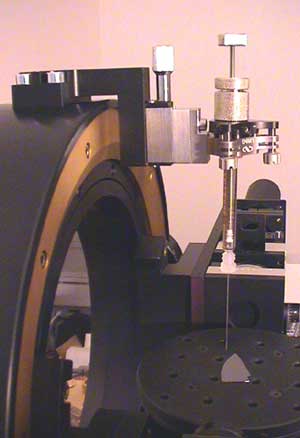
The Syringe is fixed on top of the goniometer.
It can be moved in x,y,z- direction. |
The most recent extension is the contact angle module. The contour of a sessile drop is analyzed and fitted to the Young-Laplace equation. The module uses many existing hardware components of The Multiskop such as framegrabber, CCD-camera, sample stage, computer etc. and is therefore a consequent extension of its capabilities.
A contact angle measurement requires the precise determination of the location of the three phase contact point. Many commercial programs demand further user input to solve this task but not our program CAM. The implemented contour tracing algorithm is smart enough to distinguish between drop and mirror image. The contact angle is then calculated at the intersection of mirror and drop contour. This is fast, accurate and user friendly.
|
